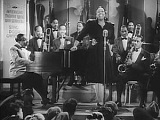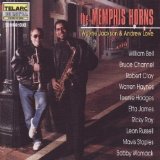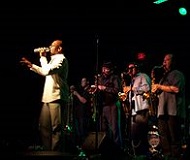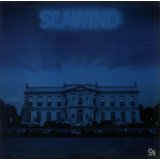Our next contributor plays saxophone with Southside Johnny and The Asbury Jukes but also released a strikingly good album this year as part of the New York Horns which is one of Allan’s albums of the year. When we asked him for a High Fives piece, here’s what he came up with. We think you’ll like this.
5 Horn Sections That Changed My Life
As a saxophone player, one of my absolute favorite ways to make music is with other horn players. Give me a trumpet or two, a couple of other saxophone players and a trombone to add some love, and you’ve got a recipe for a whole lotta fun. If the rhythm section is the meat and potatoes, and the vocalist is dessert, then the horn section is the salt. We bring out all the other flavors and make everything oh so much sweeter.
In thinking about the subject matter for this best-of list, it quickly dawned on me that I had MANY more than five examples that I could draw upon to make my point. So many that I almost gave up! After some careful consideration though, here’s five of the horn sections that have changed my life through their contributions to the music:
THE swingin-est band in the history of jazz. Count Basie’s band emerged in the 1930’s in Kansas City, and became the de facto definition of foot-stomping swing with their penchant for shouting blues, riffing head arrangements, and an infectious groove that just made you want to dance. The jazz traditions of “riffing” and “head arrangements”, while not originating with the Basie band, were certainly developed and forwarded onward by the band. Many of the riffs, licks and phrases that you will hear modern horn sections play can trace some or part of their lineage back to the Basie band. Check out “The Atomic Mr. Basie” (1957) and “Count Basie Swings, Joe Williams Sings” (1956). Two of my all time favorite Basie albums.
James Brown redefined popular music. He also redefined the role of the horn section in popular music. Prior to his influence, horns would generally have a more melodic role – playing melodies and generally being in a “lead” role. The late swing and early jump blues bands often were led by horn players and under the vocals the horns played a large supporting role, remaining a mostly harmonic underpinning. James changed all that. The horn section under James Brown became another rhythmic instrument, driving and propelling the groove. With snapping rhythmic pulses and repeating motifs, the horn section was another texture in the rhythm section, adding propulsion and rhythmic intensity. Check out “Mother Popcorn”, “Super Bad”, “Soul Power” and “Cold Sweat” for classic examples. The JB Horns (Maceo Parker, Fred Wesley, Alfred “Pee Wee” Ellis) also were a fixture of P-Funk and Bootsie’s (Collins) Rubber Band, as the Horny Horns.
Growing up in North Carolina, in the southern United States, it was inevitable that I was exposed to the music coming out of Memphis, Tennessee and especially STAX Records. Wayne Jackson and Andrew Love, aka the Memphis Horns, are one of the most recorded horn sections in history. If you’ve heard “Dock Of The Bay”, “Soul Man”, “Hold On I’m Comin’”, “Suspicious Minds”, “Sweet Caroline”, “Takin’ It To The Streets”, “Let’s Stay Together”, “Born Under A Bad Sign”, “Knock On Wood” (and countless other hits), then you’ve heard the Memphis Horns. They appeared on virtually every STAX recording, backing Otis Redding, Sam & Dave, Eddie Floyd, Carla & Rufus Thomas and an endless list of others. Not only were they a staple of the Memphis scene but could also be found as part of the Muscle Shoals scene, and on recordings with Aretha Franklin and Wilson Pickett.
No modern horn player that plays funk, soul or R&B hasn’t heard of or spent time studying TOP. Bursting onto the scene in Oakland, CA in 1968, Tower saw its peak success from 1973 to 1974. The band continues to tour extensively to this day, playing hundreds of shows every year across the world. The horn section has been featured on countless recordings by artists as diverse as Little Feat, Graham Central Station, The Monkees, Santana, Elton John, John Lee Hooker, Rufus, Rod Stewart, Huey Lewis and the News, and Aerosmith and has come to define a punchy, modern and funky style of writing and performing for horns. Check out “Tower of Power” (1973) and “Back to Oakland” (1974) for the definitive TOP experience.
While not a horn section unto himself, Jerry Hey has probably written more horn arrangements for hit songs and albums than anyone else in the business. As part of the Seawind Horns, Jerry was brought to the attention of Quincy Jones. That relationship led to Jerry’s writing for some of the biggest names in the industry. His credits as an arranger include albums from Michael Jackson, Brothers Johnson, Donna Summer, Rufus, George Benson, Patti Austin, James Ingram, Frank Sinatra, Barbra Streisand, Earth, Wind and Fire , Al Jarreau, Chaka Khan, and the list goes on… Two of my favorite albums that feature Jerry’s writing (and the Jerry Hey Horns) extensively are Al Jarreau’s “Jarreau” and “High Crime” (Check out “Imagination”!) and likely my all time favorite Jerry Hey arrangement (and performance) is from Michael Jackson’s “Workin’ Day And Night” (“Off The Wall”).
I could go on and on… there are so many great horn sections, players and writers out there, making incredible music. Hopefully this list will give you some food for thought and a good place to begin to explore the horn section legacy. Enjoy!
So it’s time to move on to the second half of the seventies and the early eighties and we start off with the P-word.
AM – How did you react when punk came along then?
PB – Loved it; I actually loved it and weirdly I wanted it to do what it wanted to do because up to that point my heroes were not punk at all and the very antithesis of punk. I wanted it, because I would have been about seventeen then, leaving school, and just starting to think about playing music in pubs and got a band together; well, actually, I got a duet together with Martin Gore (yes, that Martin Gore) and we were trying to write songs. He liked, I don’t know who he liked, I think it was Simon and Garfunkel at the time and he did like Sparks and David Bowie. I liked David Bowie but I wasn’t sure, I didn’t trust him which now, I think, was probably wrong, but I didn’t get the idea that superficial and chameleon-like was his theme. At the time I thought ‘I don’t believe he really means this’ and at that time it had to mean it and that meant a lot to me and I was probably wrong and Gore was probably way ahead of me on that. So we wrote songs which I tried to make melodic and soulful and he wanted to make strange and weird. I taught him how to play guitar and he was a better guitar player than he is, well, what he’s ended up as. We were writing some interesting songs at the time and we went out as this strange band and the punk happened, halfway through this band.
I had hair like Marc Bolan at the time and he had a bubble-cut but we found ourselves on these punk bills. I’d started writing a few songs as well, so I found myself as a solo person on these punk bills for no reason whatsoever because I had nothing to do with punk musically but I liked the fact you could play somewhere and there was energy there and I started listening to other people who were playing and I thought I’ll have a listen to this, so I went along to see some bands. I saw The Buzzcocks, The Ramones and The Talking Heads when they first came over, I saw The Clash once and there was a big fight so I didn’t hear much of The Clash, but that wasn’t the point in a way. I tended to like a what went on afterwards in the post-punk era; I got really well into that because there seemed to be room for bands like Television and The Fall with some of their lyrics which, at that point, were suddenly taking over for me and I went from trying to write songs like James Taylor with three words in them to two chords and “War and Peace” over the top of them; “Ulysses” or something like that, but then there were bands that that was feeding into at the time like The Fall. I certainly got heavily into The Fall and the more experimental bands but I would still listen to “The Modern Dance” by Pere Ubu and then go home and listen to “Mud Slide Slim and the Blue Horizon” by James Taylor because I think that’s what it’s about; they’re not dissimilar in the sense that the person who’s responsible for the music does what he wants it to do. There’s too many categories, in a way.
AM – I know Television, “Marquee Moon”, everybody claims now that it’s always been their favourite album and at the time…
PB – They’re fucking lying; I tried to get everyone into that and a couple of people got it, but for once the rabid NME press was right about this.
AM – For me it’s still one that I’m happy to get the vinyl copy out and stick it on the turntable.
PB – It is actually an album I can listen to at any time and that’s a rare thing. Sometimes, even your favourite albums you think ‘I’m not in the mood for that’, but I can be depressed, I can be happy, I can be whatever, but when Television comes on, that’s it.
AM – So, that was punk, what about what came after that.
PB – Punk was exciting and I was involved in the energy of it; everywhere you went there were gigs. I sounded like Leonard Cohen at that time but anything went and that was the beauty of it. I wore flares and had long hair at the punk gigs I did and it was, sort of, ok. You’d get comments, but that was sort of the point; wait until Dexys Midnight Runners sing about ‘you’re so anti-fashion, wear flares”. You could do anything you liked, it was sort of Dadaist spirit. It was very early on when the fashion thing kicked in, the Kings Road punks, and it was weird because I felt like I’d transcended that because I hadn’t changed. I didn’t even cut my hair so I was like David Crosby amongst the punks.
AM – So presumably when the synthesisers kicked in that wouldn’t really have been your thing.
PB – When the post-punk thing happened, I used to like some of the bands that became known as Krautrock, Can, Neu and the newer ones as well, Deutsch Amerikanische Freundschaft and Einsturzende Neubauten who were pure noise and distortion and the English versions of that like Cabaret Voltaire; I loved all of that. I thought there’s a synth thing going on and Martin got into it, so he buggered off and did Depeche Mode. Suddenly it turned into this really twee pop with no substance. I don’t hate pop music but I thought, with everything he knew, and the stuff he liked, I thought he would have gone towards Throbbing Gristle rather than this thing that happened, which seemed like it was going to be over in five minutes. For all I know he’s now a multi-millionaire and I’m sitting in a pub in Leigh.
AM – It’s a general thing that innovations like that come along, people make really good music and then somebody grabs bits of it for the mainstream and just dilutes it.
PB – That’s always happened. Bob Dylan wouldn’t have been anywhere if it wasn’t for The Byrds; fabulous as that was, I’d rather hear Dylan. I’m probably alone in the world in preferring “All Along the Watchtower” by Bob Dylan to the Hendrix version, even though I like Jimi Hendrix. I’m alone, even Bob Dylan said it’s a better version.
AM – Dylan’s songs have been interpreted by a lot of people; are they better versions or are they different versions?
PB – They’re different versions. Sometimes you can say they’re better versions but the thing I always try to get away from is ‘Dylan’s a fabulous songwriter and an icon of the twentieth century but he can’t sing’. So that means that if Judy Collins or some such does a version of “Idiot Wind”, it will be better, de facto, because she can sing. I could not disagree with anything, outside of UKIP, more vehemently than that. Bob Dylan and Sinatra are probably the best vocal stylists of this millennium. The reason I say that is because you try to play a Bob Dylan song and sing it and not sing a bit like Bob Dylan, not phrase it like him. The same with Sinatra, once you’ve heard “You Make me Feel So Young”, you try and sing that differently. Put your own slant on that; you can’t.
AM – I play and sing badly but I try Dylan songs like “I Shall be Released” and it’s always going to sound like Dylan.
PB – The Band did that; they’ve got some great singers in that band, and it sounded like Dylan; they couldn’t change the phrasing at all. You can sing it in a bland way or you can over-sing it; my worst nightmare is that I’ll wake up and “Positively Fourth Street” is covered by Mariah Carey. She would do it and you can guarantee you would have a queue of people saying ‘Oh, at last this song has been realised by a true singer’, but I would hunt her down and you’d see me on the Six O’Clock News if that happened.







